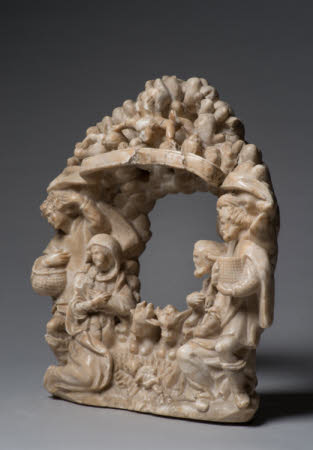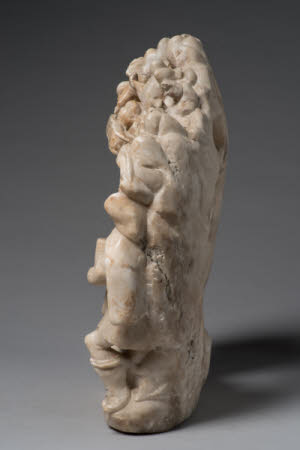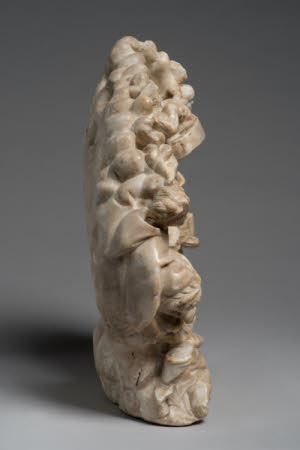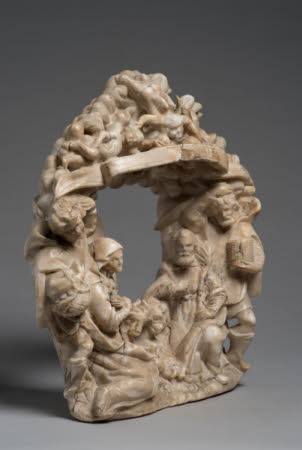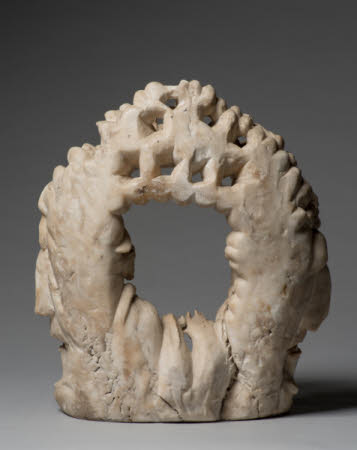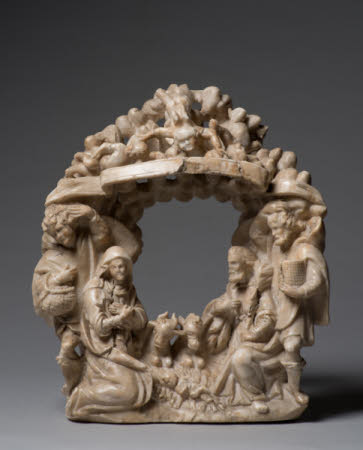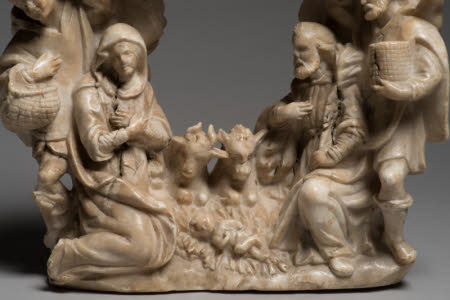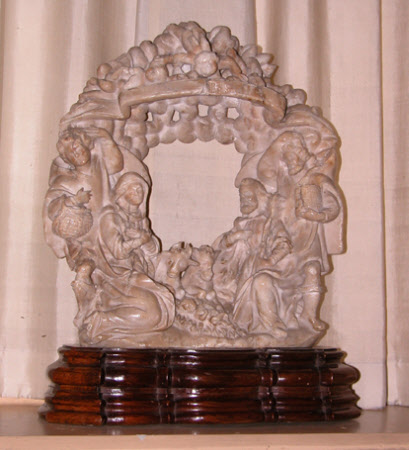The Nativity with the Shepherds
Sicilian (Trapanese) School
Category
Art / Sculpture
Date
1600 - 1700
Materials
Alabaster
Measurements
325 x 334 x 143 mm
Place of origin
Trapani
Order this imageCollection
Anglesey Abbey, Cambridgeshire
NT 516581
Summary
Alabaster, The Nativity with the Shepherds, Sicilian (Trapanese) School, 1600-1700. A sculpture carved in alabaster in Trapani, Sicily, c. 1600-1700, depicting the Nativity of Christ with the Shepherds, with Mary and Joseph kneeling in prayer, the Christ Child in a straw cradle on the ground between them. The ox and the ass lie on the ground, looking inwards towards Christ. To the sides, standing figures of two shepherds, each carrying a basket in their arms and some form of load (perhaps a lamb) on their shoulder, which they hold steady with their other hand. The relief has a space at the centre, closed at the top by billowing clouds, within which are four holes and, at the very top, three flying angels holding a banderole. Now mounted on a modern wooden base.
Full description
This delightful and original depiction of the Nativity of the Shepherds presents the Holy Family flanked by shepherds, with the Child Jesus the centre of adoration in the centre, the ox and the ass appearing to rest the knees of their front legs upon the straw crib. The scene is closed off by a curtain of clouds within which is a scroll, held by three bullet-like angels which appear to hurtle towards the spectator. Its most curious feature is the large opening in the middle, together with smaller holes above. It may be that these were intended for the projection of some light source. The sculpture appears to be a typical product of the alabaster workshops that flourished in Sicily, notably in Trapani, from the 16th century onwards, in which enormous numbers of carvings were made, using the characteristic locally-mined form of red-veined stone known as alabastro rosa or pietra incarnata. The Jesuit Guglielmo Gumppenberg recorded in 1672 that there were around forty workshops in Trapani, in which the principal occupation was the production every year of around 5,000 small images of the Madonna of Trapani, mostly in alabaster (an example at Anglesey Abbey, NT 516604), but also in coral, the material for which Trapani is best known (Guilielmus Gumppenberg, Atlas Marianus, Munich 1672, p. 120). The active participation of the ox and the ass in the adoration scene seems to be a particular characteristic of Nativity scenes made in Sicily. The overall concept of the Anglesey Abbey Nativity, with its quiet intimacy, seems to derive from fifteenth-century small-scale reliefs of the Nativity by the Renaissance sculptors Francesco Laurana (c. 1430- before 1532) and members of the Gagini dynasty of sculptors. These are often found in Sicily forming part of the base of Virgin and Child statues, for example, the relief of the Nativity on the base of the Madonna and Child group from the workshop of Francesco Laurana in the Cappella Mastrantonio in the Basilica di San Francesco d’Assisi in Palermo (Maria Concetta di Natale and Vincenzo Abbate, eds., In Epiphania Domini. L’adorazione dei Magi nell’arte siciliana, exh. cat., Cattedrale di Palermo, Palermo 1992, pp. 41-42, fig. 4; Hanno-Walter Kruft, Francesco Laurana. Ein Bildhauer der Frührenaissance, Munich 1995, pp. 103-05, Abb. 83-84). Another such scene by Antonello Gagini (1478-1536) forms the base of the Virgin and Child of Divine Love figure in the church of S. Maria di Gesù in S. Piero Patti (In Epiphania Domini, p. 45, fig. 9). Its setting of the scene within a cavern, with an open sky visible through the cave’s entrance, might have been the starting point for the unusual form of the Anglesey Abbey sculpture. A small Nativity scene in alabaster which is very similar to the Anglesey Abbey relief is in the Museo Diocesano in Caltanisetta in central Sicily, on deposit from the church of the Anime Sante in Santa Caterina Villarmosa. This version, mounted on an elaborate carved alabaster base, has no fewer than eight putti frolicking in the clouds. Jeremy Warren 2020
Provenance
Acquired by Huttleston Rogers Broughton, 1st Lord Fairhaven (1896-1966) between 1932 and 1940; identifiable in the Anglesey Abbey inventory 1940, p. 229, Abbey Room, “The Finding of Moses” (sic), valued at £20; bequeathed by Lord Fairhaven to the National Trust in 1966 with the house and the rest of the contents.
Credit line
Anglesey Abbey, The Fairhaven Collection (The National Trust)
Makers and roles
Sicilian (Trapanese) School, sculptor
References
'Anglesey Abbey, Lode, Cambridgeshire. An Inventory and Valuation of Furniture, Books, Ornamental Items & Household Effects .. prepared for Insurance Purposes’, Turner, Lord and Ransom, April 1940, p. 229. Christie, Manson & Woods 1971: The National Trust, Anglesey Abbey, Cambridge. Inventory: Furniture, Textiles, Porcelain, Bronzes, Sculpture and Garden Ornaments’, 1971, p. 133, First Strong Room. Warren 2021: Jeremy Warren, ‘New perspectives on alabaster sculpture from Trapani‘, Colnaghi Studies Journal, Vol. 8 (March 2021), pp. 115-47
